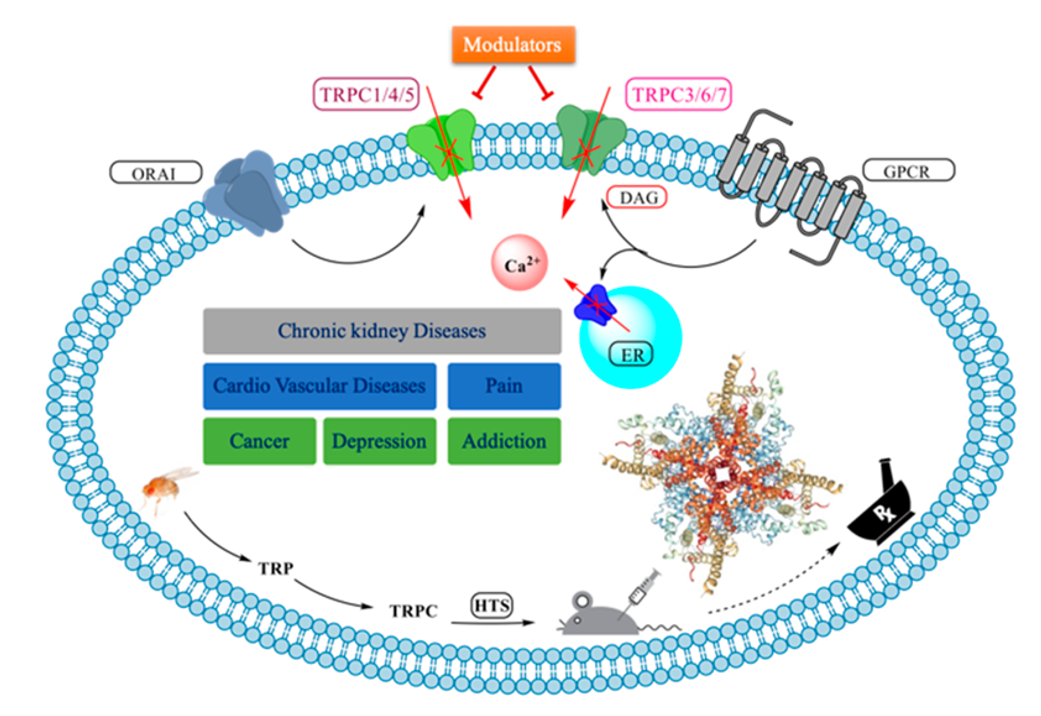
Our promise to you:
Guaranteed product quality, expert customer support.
 24x7 CUSTOMER SERVICE
24x7 CUSTOMER SERVICE
 CONTACT US TO ORDER
CONTACT US TO ORDER
TRPC5 Gene Editing 
Canonical transient receptor potential (TRPC) channels are a group of mammalian Ca2+-permeable channels sharing homology with Dreactive oxygen speciesophila TRP channel. Seven different TRPC homologs have been isolated and, and according to the sequence homology, can be divided into four subgroups, TRPC1, TRPC4/5, TRPC3/6/7, and TRPC2. TRPC5 has a variety of physiological functions and has attracted extensive attention. TRPC5 expression has been found in many cell types with inheriting mechanosensitive Ca2+ influx, such as endothelial cells, smooth muscle cells, cardiac myocytes and arterial baroreceptor neurons. It can form channels on its own or assemble with TRPC4. The small ring in front of the disulphide bond in the extracellular region is the key functional region of TRPC5. Studies have shown that TRPC5 channels are involved in a variety of physiological and pathophysiological processes, including vascular smooth muscle, endothelial function, oxidative stress, adiponectin regulation, anxiety, epilepsy, pain and cardiac remodeling.
 Figure 1. TRPC channels. (Sharma S, Hopkins C R. 2019)
Figure 1. TRPC channels. (Sharma S, Hopkins C R. 2019)
TRPC5 Physiological Functions
Homotetrameric assembly of TRPC5 proteins acts as a receptor-activated Ca2+-permeable cation channel, while in complexes with other proteins, TRPC5 can mediate store-operated channels (SOC). TRPC5 can be directly activated by a variety of factors, and it reportedly receives multiple modulatory inputs. Moreover, one recent study has identified Gi3 subunits as novel direct activators of TRPC5 channels. Gi3 interacts with the SESTD1B domain, which largely overlaps with the CIRB domain. Therefore, TRPC5 can potentially integrate activation of differentially coupled (Gq and Gi) receptors being a focal point in GPCR signalling.
One of the most widely investigated physiological functions of TRPC5 concerns its key role in axon guidance during brain development. Clapham and co-workers found that in young rat hippocampal neurons expression of dominant negative TRPC5 enhanced neurite extension, while overexpression of wild-type TRPC5 inhibited nerve growth. They attributed this function to regulated transmission of TRPC5 to growth cones, where it may mediate receptor-operated Ca2+ entry. In addition, NCS-1 and TRPC5 were found to interact in retardation of neurite outgrowth. In non-neuronal tissues, TRPC5 seems to have somewhat related functions in the regulation of actin remodelling and cell motility. Therefore, in complex with Rac1, TRPC5 promotes cell migration in fibroblasts and kidney podocytes, while activated by S1P it stimulates vascular smooth muscle migration. On the contrary, activation of TRPC5 by LPC inhibits migration of endothelial cells.
TRPC5 as A Therapeutic Target
Blocking TRPC5 channels can inhibit atherosclerotic plaque formation, reduce the expression of cardiac hypertrophy associated genes, maintain stability of cardiac electrical activity, and thus play the role of anti-AS, anti-cardiac hypertrophy and anti-arrhythmia. Besides, blocking TRPC5 can prevent depression and anxiety, regulate blood lipids, improve renal function, and thus play a synergistic role in improving the prognosis of cardiovascular disease patients. However, activation of TRPC5 channels can also promote angiogenesis, regulate blood pressure, and has the potential to stabilize blood pressure as well as resist ischemia. There are also conflicting findings regarding the role of TRPC5 in inflammation and renal therapy. Therefore, in order to explain these controversies and develop clinical drugs with high specificity which produce few side effects, the related signaling pathways and molecular mechanisms should be confirmed by further researches. In general, the TRPC5 channel should still be considered as a promising therapeutic target for regulating heart disease.
At present, several small molecular compounds have been used in basic experiments, such as ML204, AC1903, HC-070, in addition to others. Laboratory studies of these smaller molecular compounds may provide valuable insights into the roles of TRPC5 within cells and animal disease models. This is beneficial for the development of new drugs targeting TRPC5. In addition, in order to conveniently detect the expression of TRPC5 under different conditions, researchers have synthesized a TRPC5 PET radiotracer, [11C]HC608, to quantify TRPC5 expression changes in the brain. These methods would benefit our understanding of the roles of TRPC5 in the heart, especially if PET-CT and tracers were used for quantification of TRPC5 expression in cardiovascular diseases.
TRPC5 Gene Editing Services
CRISPR/Cas9 PlatformCB at Creative Biogene is dedicated to offering comprehensive CRISPR/Cas9 gene editing services and products for academic research, biotech research and pharmaceutical drug discovery. With deep gene editing knowledge and extensive experience in experimental operation and data processing, we help you effectively control TRPC5 genes knockout/knockin/point mutation in cells or animals via CRISPR/Cas9 technology.
| Service | Details | Alternative cell lines or animal species |
| TRPC5 Gene Editing Cell Line Generation | gRNA design and synthesis Transfect the cell lines you're interested Select the high expression cells and sort monoclonal cell Validate the knockout/knockin/point mutation of TRPC5 by PCR and sequencing Provide cryogenically preserved vials of stable cells and final reports | HEK239T, Hela, HepG2, U87, Ba/F3, CHO, MDA-MB-453, MDA-MB-231NIH3T3, T47D, Neuro2a, MCF7, RKO, K562, RAW264.7, etc. |
| TRPC5 Gene Editing Animal Model Generation | TRPC5 gene conventional knockout animals TRPC5 gene conditional knockout animals TRPC5 point mutation animals TRPC5 knockin animals | Mouse, rat, rabbit, zebrafish, C. elegans, etc. |
Related Products at CRISPR/Cas9 PlatformCB
References
- Zholos A V. Trpc5. Mammalian Transient Receptor Potential (TRP) Cation Channels, 2014: 129-156.
- Van Der Wijst J, Bindels R J M. TRPC5 inhibition to treat progressive kidney disease. Nature Reviews Nephrology, 2018, 14(3): 145-146.
- Li Z, et al. TRPC5 channel modulates endothelial cells senescence. European journal of pharmacology, 2017, 802: 27-35.
- Sharma S, Hopkins C R. Review of transient receptor potential canonical (TRPC5) channel modulators and diseases: miniperspective. Journal of medicinal chemistry, 2019, 62(17): 7589-7602.
- Du S L, et al. TRPC5 in cardiovascular diseases. Reviews in Cardiovascular Medicine, 2021, 22(1): 127-135.